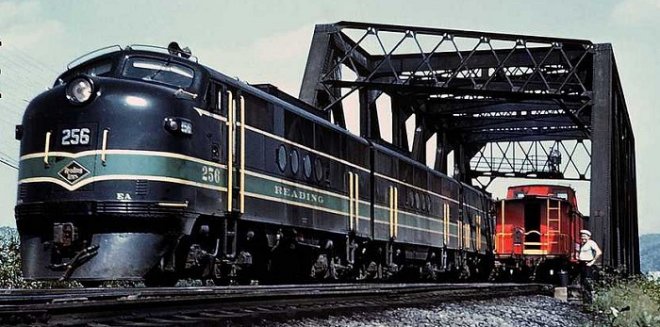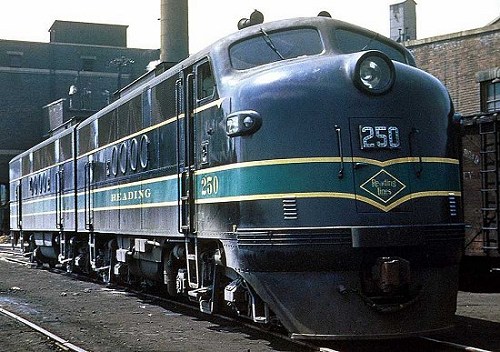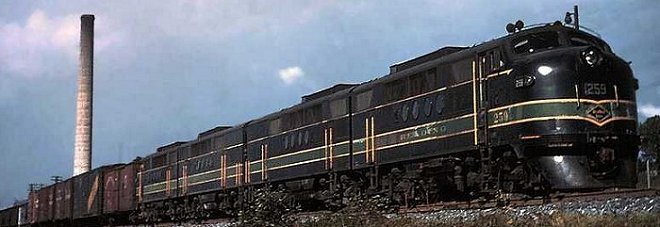EMD: FT

Introduced in 1939, the EMD (Electro-Motive Division - General Motors) FT locomotive was "the diesel that did it," proving the viability of diesel power in road freight service and portending the eventual end of steam power in American railroading. These units allowed railroads across the country to run heavier trains more cost-effectively, FT stands for "Freight - Twenty-seven hundred horsepower." Each "unit" consisted of a 1350HP A unit with cab and a cabless 1350HP B unit, connected by a drawbar, for a total of 2700 horsepower. EMD sent its demonstrator unit on a nationwide tour between 1939 and 1940, which had an impact on the Reading's management (who generally had a very progressive mindset regarding motive power technology), and the railroad placed an order for ten units in 1943 at a cost of roughly $2.5 million.

The Reading's ten FT locomotives were delivered in 1945, ironically at the same time the famed T-1 4-8-4 steam locomotives were under construction! These units were given class DF-1 for "Diesel Freight, first type purchased," and were numbered 250 A/B to 259 A/B. They weighed in at 457,700 lbs., starting tractive effort of 124,425 lbs. and continuous rating of 60,800 lbs. at 14 mph. They were also equipped with a gear ratio of 65:12 making their top speed 65 mph.
The FT units were the first to carry the attractive black with green/yellow stripe paint scheme, which would become standard for cab units on the Reading. Ever mindful of its corporate image, management sent letters to shop personnel stating that the FTs should be "operated in a clean, presentable condition," and they were even waxed during their early years of service, which would eliminate the need for weathering your model!
 Upon entry into service, the Reading's FTs were put into service between Tamaqua and Newberry Junction, eliminating the need for helpers on the Catawissa Branch. As more diesel road power arrived on the railroad a few years later, the FTs began to travel beyond the Shamokin Division and were seen powering more Main Line and Crossline trains. As seen in the photo above, in order to achieve adequate horsepower, the FTs were often operated as an ABBA set. As part of its efforts to dieselize passenger service, the Reading looked into having several units fitted with steam boilers for possible passenger service, but the cost was too expensive. While the Reading eventually dieselized passenger operations through the purchase of FP7s and the use of road switchers in passenger service, FT's did occasionally pull some passenger trains during the summer months, when steam heat was not required.
Upon entry into service, the Reading's FTs were put into service between Tamaqua and Newberry Junction, eliminating the need for helpers on the Catawissa Branch. As more diesel road power arrived on the railroad a few years later, the FTs began to travel beyond the Shamokin Division and were seen powering more Main Line and Crossline trains. As seen in the photo above, in order to achieve adequate horsepower, the FTs were often operated as an ABBA set. As part of its efforts to dieselize passenger service, the Reading looked into having several units fitted with steam boilers for possible passenger service, but the cost was too expensive. While the Reading eventually dieselized passenger operations through the purchase of FP7s and the use of road switchers in passenger service, FT's did occasionally pull some passenger trains during the summer months, when steam heat was not required.
After a major overhaul in the Reading Shops during 1955, the FTs continued to toil on the Reading until 1962 when they were traded to EMD toward the purchase of the new GP-30 units. It is fitting that the first "first-generation" road power would help usher in the first "second-generation" locomotives on the Reading!

Did You Know?
Downloads
 A variety of Reading Company operations related documents, etc. that may be of use in your modeling efforts.
A variety of Reading Company operations related documents, etc. that may be of use in your modeling efforts.
 A variety of Reading Company operations paperwork, such as train orders, clearance forms, etc. that will help you operate your Reading layout in a prototypical manner.
A variety of Reading Company operations paperwork, such as train orders, clearance forms, etc. that will help you operate your Reading layout in a prototypical manner.
 Public Timetables, Employe Timetables, and Rulebooks that provide much useful operational information.
Public Timetables, Employe Timetables, and Rulebooks that provide much useful operational information.
 Signs, billboards, and other FREE goodies for your use. We ask only that you help spread the word about The Reading Modeler!
Signs, billboards, and other FREE goodies for your use. We ask only that you help spread the word about The Reading Modeler!

